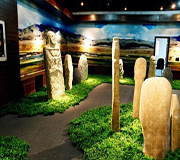Join-in Group Silk Road China Tours
About Us | Contact us | Tourist Map | Hotels | Feedback
Urumqi Attractions

Overview:Situated in Xibei Lu, in Urumqi City, the Xinjiang Regional Museum is a large integrated museum and centre for the collection and study of cultural relics discovered in the region.
Situated in Xibei Lu, in Urumqi City, the Xinjiang Regional Museum is a large integrated museum and centre for the collection and study of cultural relics discovered in the region.
Built in 1953, it has an exhibition hall that covers an area of about 7,800 square meters (approx. 9,328 square yards). The building is in a Uigur style, the internal decor having strong ethnic features.
In total there are over 50,000 items in the collection. These not only represent the ethnic lifestyle and humanity of the region but also illustrate its revolutionary spirit. With such an abundance of items on display, the exhibition is widely acknowledged for its comprehensive and informative nature both at home and abroad.
The exhibition relating to folk customs includes costumes, tools and every day necessities. Together they vividly illustrate for us the dress, lifestyle, religion, marriage customs, festivals and other aspects of the colorful life of the 12 minorities that live in Xinjiang.
The historical relics include carpentries, ironwares, bronze wares, bright and beautiful brocades, tomb figures, pottery, coins, rubbings from stone inscriptions, and writings as well as weapons and so on. These give an insight into the past and show how the society of Xinjiang developed. There is even the fossil of a human head that dates back some 10,000 years.
The display of ancient corpses is fantastic, for it was in this region that a great number of ancient and well preserved remains were discovered. These are quite different from the mummies in Egypt that were created by skilled embalming procedures; the corpses here were dried by the particular natural environment. In all there are twenty-one specimens in the collection and include men, women, lovers, and generals. The 'Loulan beauty' is among the best preserved and famous ones. The 'Loulan beauty' has a reddish brown skin, thick eyelashes, charming large eyes, and long hair. This particular 'charming' corpse has survived for an estimated 4,000 years.


